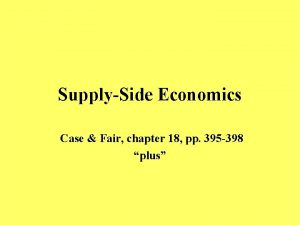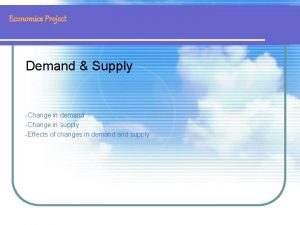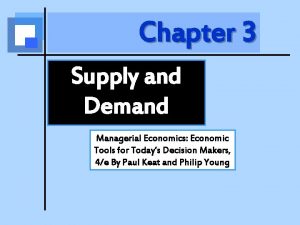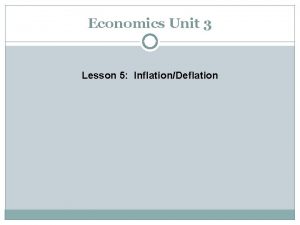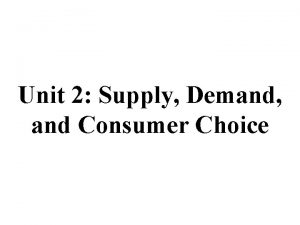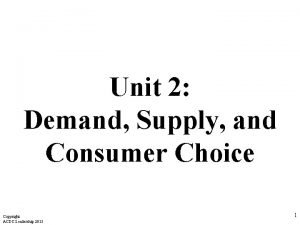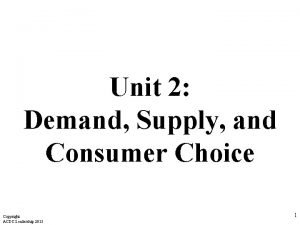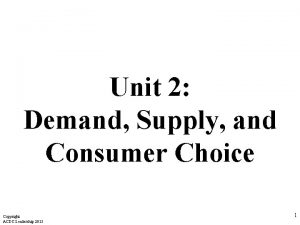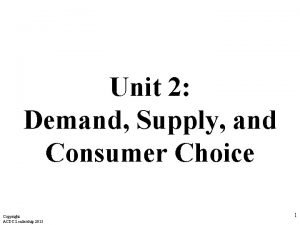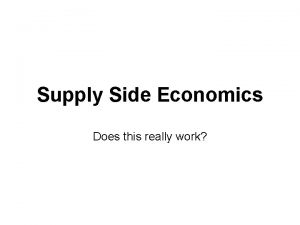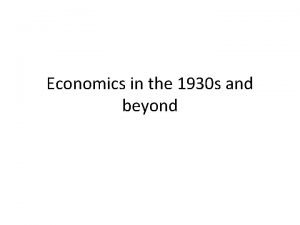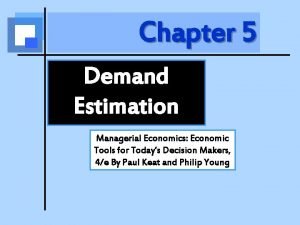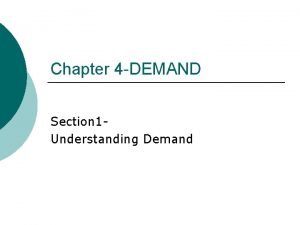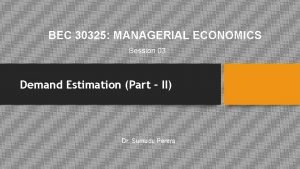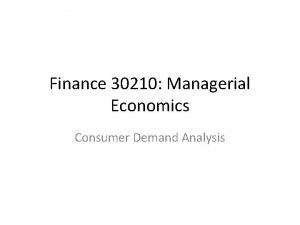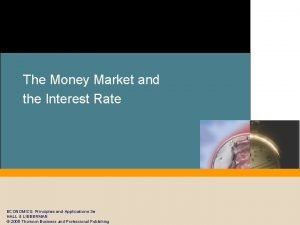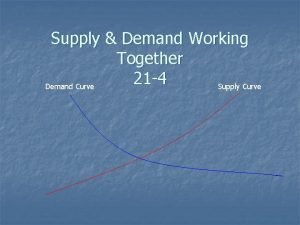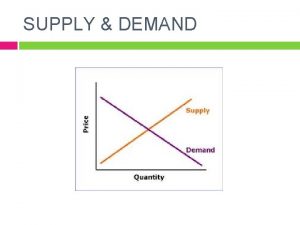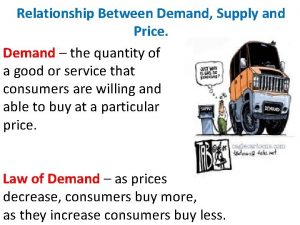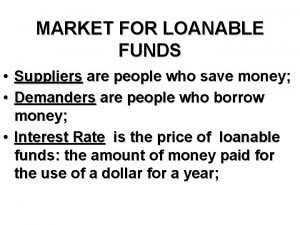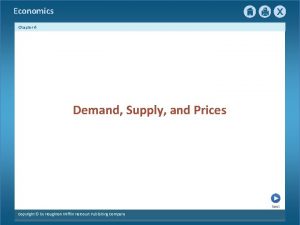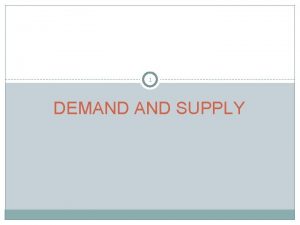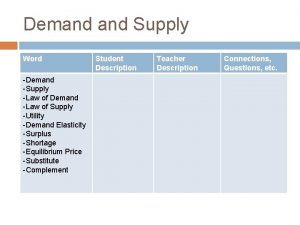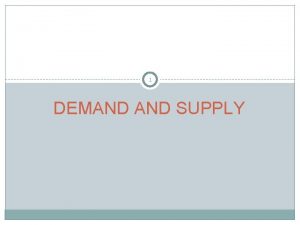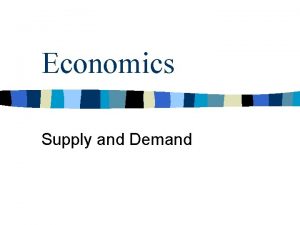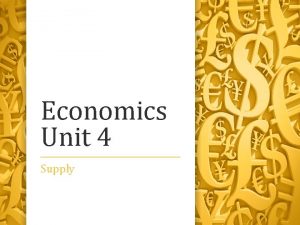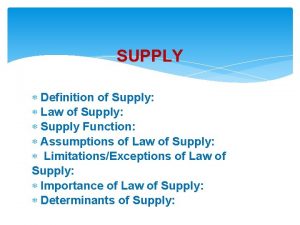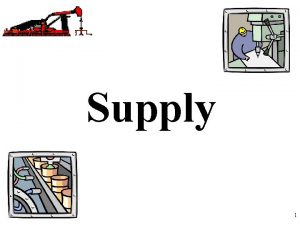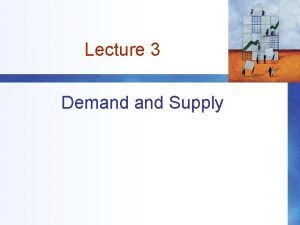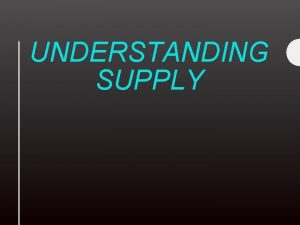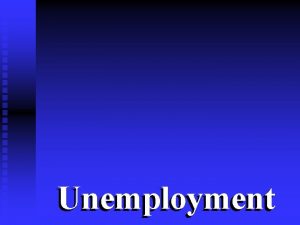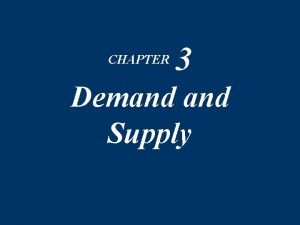Economics 12 Unit 2 Demand Supply Demand p








































- Slides: 40

Economics 12 Unit 2 – Demand Supply

Demand p The quantities that consumers are willing and able to buy period of time at various prices © 2002 Prentice Hall Business Publishing Principles of Economics, 6/e Karl Case, Ray Fair

Demand Involves both the consumers’ desire and ability to purchase p Assumes that other things are held constant (ceteris paribus) p Refers to ranges of prices p Measures quantities over time p © 2002 Prentice Hall Business Publishing Principles of Economics, 6/e Karl Case, Ray Fair

Determinants of Household Demand A household’s decision about the quantity of a particular output to demand depends on: p The price of the product in question. p The income available to the household. p The household’s amount of accumulated wealth. p The prices of related products available to the household. p The household’s tastes and preferences. p The household’s expectations about future income, wealth, and prices. © 2002 Prentice Hall Business Publishing Principles of Economics, 6/e Karl Case, Ray Fair

Quantity Demanded p Quantity demanded is the amount (number of units) of a product that a household would buy in a given time period if it could buy all it wanted at the current market price. © 2002 Prentice Hall Business Publishing Principles of Economics, 6/e Karl Case, Ray Fair

Demand in Output Markets p p © 2002 Prentice Hall Business Publishing A demand schedule is a table showing how much of a given product a household would be willing to buy at different prices. Demand curves are usually derived from demand schedules. Principles of Economics, 6/e Karl Case, Ray Fair

The Demand Curve p © 2002 Prentice Hall Business Publishing The demand curve is a graph illustrating how much of a given product a household would be willing to buy at different prices. Principles of Economics, 6/e Karl Case, Ray Fair

The Law of Demand p p © 2002 Prentice Hall Business Publishing The law of demand states that there is a negative, or inverse, relationship between the quantity of a good demanded and its price. This means that demand curves slope downward. Principles of Economics, 6/e Karl Case, Ray Fair

Income and Wealth Income is the sum of all households wages, salaries, profits, interest payments, rents, and other forms of earnings in a given period of time. It is a flow measure. p Wealth, or net worth, is the total value of what a household owns minus what it owes. It is a stock measure. p © 2002 Prentice Hall Business Publishing Principles of Economics, 6/e Karl Case, Ray Fair

Related Goods and Services Normal Goods are goods for which demand goes up when income is higher and for which demand goes down when income is lower. p Inferior Goods are goods for which demand falls when income rises. p © 2002 Prentice Hall Business Publishing Principles of Economics, 6/e Karl Case, Ray Fair

Related Goods and Services p Substitutes are goods that can serve as replacements for one another; when the price of one increases, demand for the other goes up. n p Perfect substitutes are identical products. Complements are goods that “go together”; a decrease in the price of one results in an increase in demand for the other, and vice versa. © 2002 Prentice Hall Business Publishing Principles of Economics, 6/e Karl Case, Ray Fair

Shift of Demand Vs Movement Along a Demand Curve p p p © 2002 Prentice Hall Business Publishing A change in demand is not the same as a change in quantity demanded. In this example, a higher price causes lower quantity demanded. Changes in determinants of demand, other than price, cause a change in demand, or a shift of the entire demand curve, from DA to DB. Principles of Economics, 6/e Karl Case, Ray Fair

A Change in Demand Versus a Change in Quantity Demanded p © 2002 Prentice Hall Business Publishing When demand shifts to the right, demand increases. This causes quantity demanded to be greater than it was prior to the shift, for each and every price level. Principles of Economics, 6/e Karl Case, Ray Fair

A Change in Demand Versus a Change in Quantity Demanded To summarize: Change in price of a good or service leads to Change in quantity demanded (Movement along the curve). Change in income, preferences, or prices of other goods or services leads to Change in demand (Shift of curve). © 2002 Prentice Hall Business Publishing Principles of Economics, 6/e Karl Case, Ray Fair

The Impact of a Change in Income p Higher income decreases the demand for an inferior good © 2002 Prentice Hall Business Publishing p Higher income increases the demand for a normal good Principles of Economics, 6/e Karl Case, Ray Fair

The Impact of a Change in the Price of Related Goods p Demand for complement good (ketchup) shifts left p Demand for substitute good (chicken) shifts right p Price of hamburger rises p Quantity of hamburger demanded falls © 2002 Prentice Hall Business Publishing Principles of Economics, 6/e Karl Case, Ray Fair

From Household to Market Demand for a good or service can be defined for an individual household, or for a group of households that make up a market. p Market demand is the sum of all the quantities of a good or service demanded period by all the households buying in the market for that good or service. p © 2002 Prentice Hall Business Publishing Principles of Economics, 6/e Karl Case, Ray Fair

From Household Demand to Market Demand p Assuming there are only two households in the market, market demand is derived as follows: © 2002 Prentice Hall Business Publishing Principles of Economics, 6/e Karl Case, Ray Fair

Stop Here for Today p p p © 2002 Prentice Hall Business Publishing For a recap of today’s lesson, try: http: //www. youtube. c om/watch? v=OXJ_8 y 4 qns&feature=rel ated http: //www. youtube. c om/watch? v=BIXXB 64 L 3 M&NR=1 Principles of Economics, 6/e Karl Case, Ray Fair

Supply p The quantities that producers are willing and able to sell period of time at various prices © 2002 Prentice Hall Business Publishing Principles of Economics, 6/e Karl Case, Ray Fair

Supply in Output Markets p p © 2002 Prentice Hall Business Publishing A supply schedule is a table showing how much of a product firms will supply at different prices. Quantity supplied represents the number of units of a product that a firm would be willing and able to offer for sale at a particular price during a given time period. Principles of Economics, 6/e Karl Case, Ray Fair

The Supply Curve and the Supply Schedule p A supply curve is a graph illustrating how much of a product a firm will supply at different prices. © 2002 Prentice Hall Business Publishing Principles of Economics, 6/e Karl Case, Ray Fair

The Law of Supply P P QS QS p p © 2002 Prentice Hall Business Publishing The law of supply states that there is a positive relationship between price and quantity of a good supplied. This means that supply curves typically have a positive slope. Principles of Economics, 6/e Karl Case, Ray Fair

Determinants of Supply The price of the good or service. p The cost of producing the good, which in turn depends on: p n n n p The price of required inputs (labor, capital, and land), Business taxes levied, The technologies that can be used to produce the product. The prices of related products. © 2002 Prentice Hall Business Publishing Principles of Economics, 6/e Karl Case, Ray Fair

A Change in Supply Versus a Change in Quantity Supplied p p p A change in supply is not the same as a change in quantity supplied. In this example, a higher price causes higher quantity supplied, and a move along the demand curve. In this example, changes in determinants of supply, other than price, cause an increase in supply, or a shift of the entire supply curve, from SA to SB. © 2002 Prentice Hall Business Publishing Principles of Economics, 6/e Karl Case, Ray Fair

A Change in Supply Versus a Change in Quantity Supplied p © 2002 Prentice Hall Business Publishing When supply shifts to the right, supply increases. This causes quantity supplied to be greater than it was prior to the shift, for each and every price level. Principles of Economics, 6/e Karl Case, Ray Fair

A Change in Supply Versus a Change in Quantity Supplied To Summarize: Change in price of a good or service leads to Change in quantity supplied (Movement along the curve). Change in costs, input prices, technology, or prices of related goods and services leads to Change in supply (Shift of curve). © 2002 Prentice Hall Business Publishing Principles of Economics, 6/e Karl Case, Ray Fair

From Individual Supply to Market Supply The supply of a good or service can be defined for an individual firm, or for a group of firms that make up a market or an industry. p Market supply is the sum of all the quantities of a good or service supplied period by all the firms selling in the market for that good or service. p © 2002 Prentice Hall Business Publishing Principles of Economics, 6/e Karl Case, Ray Fair

Market Supply p As with market demand, market supply is the horizontal summation of individual firms’ supply curves. © 2002 Prentice Hall Business Publishing Principles of Economics, 6/e Karl Case, Ray Fair

Stop Here for Today p p © 2002 Prentice Hall Business Publishing For a recap of today’s lesson, try: http: //www. youtube. c om/watch? v=x 4 OKYQ Xf. EXY&feature=relate d Principles of Economics, 6/e Karl Case, Ray Fair

Market Equilibrium The operation of the market depends on the interaction between buyers and sellers. p An equilibrium is the condition that exists when quantity supplied and quantity demanded are equal. p At equilibrium, there is no tendency for the market price to change. p © 2002 Prentice Hall Business Publishing Principles of Economics, 6/e Karl Case, Ray Fair

Market Equilibrium p p © 2002 Prentice Hall Business Publishing Only in equilibrium is quantity supplied equal to quantity demanded. At any price level other than P 0, the wishes of buyers and sellers do not coincide. Principles of Economics, 6/e Karl Case, Ray Fair

Market Disequilibria p p © 2002 Prentice Hall Business Publishing Excess demand, or shortage, is the condition that exists when quantity demanded exceeds quantity supplied at the current price. When quantity demanded exceeds quantity supplied, price tends to rise until equilibrium is restored. Principles of Economics, 6/e Karl Case, Ray Fair

Market Disequilibria p p © 2002 Prentice Hall Business Publishing Excess supply, or surplus, is the condition that exists when quantity supplied exceeds quantity demanded at the current price. When quantity supplied exceeds quantity demanded, price tends to fall until equilibrium is restored. Principles of Economics, 6/e Karl Case, Ray Fair

Increases in Demand Supply p Higher demand leads to higher equilibrium price and higher equilibrium quantity. © 2002 Prentice Hall Business Publishing p Higher supply leads to lower equilibrium price and higher equilibrium quantity. Principles of Economics, 6/e Karl Case, Ray Fair

Decreases in Demand Supply p Lower demand leads to lower price and lower quantity exchanged. © 2002 Prentice Hall Business Publishing p Lower supply leads to higher price and lower quantity exchanged. Principles of Economics, 6/e Karl Case, Ray Fair

Relative Magnitudes of Change p The relative magnitudes of change in supply and demand determine the outcome of market equilibrium. © 2002 Prentice Hall Business Publishing Principles of Economics, 6/e Karl Case, Ray Fair

Relative Magnitudes of Change p When supply and demand both increase, quantity will increase, but price may go up or down. © 2002 Prentice Hall Business Publishing Principles of Economics, 6/e Karl Case, Ray Fair

That’s All for the Intro! p p © 2002 Prentice Hall Business Publishing For a recap of today’s lesson, try: http: //www. youtube. c om/watch? v=322 ZPj. Gw. GQ&feature=rel ated Principles of Economics, 6/e Karl Case, Ray Fair

Graphics Work P QS D S P P © 2002 Prentice Hall Business Publishing Q Q Principles of Economics, 6/e Karl Case, Ray Fair
 Supply side economics vs keynesian
Supply side economics vs keynesian Supply and demand economics project
Supply and demand economics project Supply and demand economics project
Supply and demand economics project Supply analysis in managerial economics
Supply analysis in managerial economics Matching supply and demand in supply chain
Matching supply and demand in supply chain Module 5 supply and demand introduction and demand
Module 5 supply and demand introduction and demand Economics unit 3 lesson 9
Economics unit 3 lesson 9 Unit 2 demand supply and consumer choice
Unit 2 demand supply and consumer choice New grilling technology cuts production time in half
New grilling technology cuts production time in half Unit 2 demand supply and consumer choice
Unit 2 demand supply and consumer choice Unit 2 demand supply and consumer choice answer key
Unit 2 demand supply and consumer choice answer key Supply and demand unit test
Supply and demand unit test Unit 2 demand supply and consumer choice
Unit 2 demand supply and consumer choice Utility maximization
Utility maximization Unit 3 aggregate demand and aggregate supply
Unit 3 aggregate demand and aggregate supply Tax multiplier formula
Tax multiplier formula Unit 3 aggregate demand aggregate supply and fiscal policy
Unit 3 aggregate demand aggregate supply and fiscal policy Economics and business economics maastricht
Economics and business economics maastricht Elements of mathematical economics
Elements of mathematical economics Supply curve economics
Supply curve economics Supply side economics
Supply side economics Monetarist vs classical economics
Monetarist vs classical economics Supply side economics
Supply side economics Unit 10, unit 10 review tests, unit 10 general test
Unit 10, unit 10 review tests, unit 10 general test Demand estimation and forecasting in managerial economics
Demand estimation and forecasting in managerial economics What is demand estimation in managerial economics
What is demand estimation in managerial economics Economics chapter 4 section 1 understanding demand answers
Economics chapter 4 section 1 understanding demand answers Demand estimation in managerial economics
Demand estimation in managerial economics Managerial economics demand analysis
Managerial economics demand analysis Economics chapter 4 demand
Economics chapter 4 demand Chapter 5 section 1 supply
Chapter 5 section 1 supply Elastisidad ng supply
Elastisidad ng supply 5 determinants of supply
5 determinants of supply Money market equilibrium
Money market equilibrium Combining supply and demand worksheet
Combining supply and demand worksheet Interaction of demand and supply
Interaction of demand and supply What is the relationship between supply and price
What is the relationship between supply and price Who are the demanders of loanable funds
Who are the demanders of loanable funds Shifters of supply for loanable funds
Shifters of supply for loanable funds Chapter 6 section 2 supply and demand in everyday life
Chapter 6 section 2 supply and demand in everyday life Halimbawa ng demand schedule at demand curve
Halimbawa ng demand schedule at demand curve
